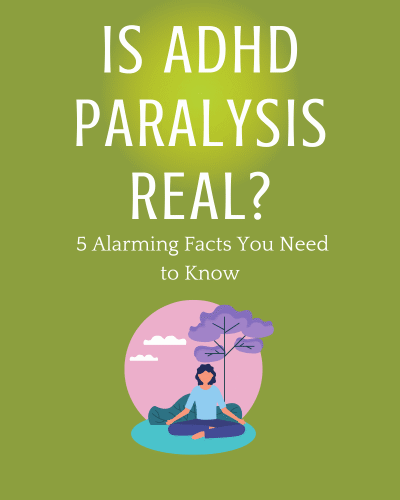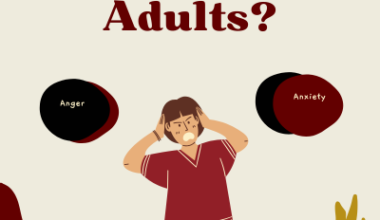Is ADHD paralysis real? Yes. ADHD paralysis occurs when your brain feels overwhelmed by tasks, decisions, or emotions, making it difficult to initiate or complete anything. You might know exactly what needs to be done, but you feel mentally stuck or frozen, unable to take action. This is a symptom of how ADHD affects the brain’s ability to plan, prioritize, and stay focused.
In this guide, Is ADHD Paralysis Real?, we’ll break down what ADHD paralysis is, why it happens, how long it can last, and most importantly, what you can do to overcome it.
Table of Contents
ToggleWhat is ADHD Paralysis?
ADHD paralysis is a term used to describe the mental shutdown that often affects people with Attention-Deficit/Hyperactivity Disorder (ADHD). It refers to a state where a person feels unable to start or complete tasks, even if they are urgent, simple, or clearly defined.
Although not a clinical diagnosis on its own, ADHD paralysis is a very real and common experience. It’s one of the ways ADHD shows up, and it’s often misunderstood. On the outside, it might seem like you’re just being lazy or putting things off. But it’s a real struggle with how the brain manages tasks.
What Causes ADHD Paralysis?
People with ADHD have brains that work differently, especially when it comes to how the brain works. The brain helps you plan, organize, start tasks, manage time, and stay focused.
When someone with ADHD is hit with too many tasks, choices, or distractions at once, their brain can get overloaded. That overload can cause a kind of mental traffic jam, where everything feels too much, and nothing feels possible to start.
Some common things can trigger ADHD paralysis. For example, having too many tasks competing for your attention at once can make it hard to know where to start. A lack of structure or not having clear next steps can leave your brain stuck in indecision.
Perfectionism or fear of failure can also add pressure that makes action feel risky. On top of that, people with ADHD often struggle with motivation, not because they’re lazy, but because their brains process differently. Emotional stress, anxiety, or even past negative experiences can also pile on, making it even harder to move forward.
Types of ADHD Paralysis
ADHD paralysis doesn’t show up the same way for everyone. It can take different forms depending on the situation and how a person’s brain responds in the moment. Below are three of the most common ways it tends to appear:
1. Task Paralysis
This is when you know exactly what needs to be done, but you can’t bring yourself to start. The task might be small or even familiar, but it feels too big to handle in the moment. You might sit for hours, trying to start, but end up doing nothing, and feeling frustrated about it.
2. Decision Paralysis
Too many choices can be overwhelming for someone with ADHD. It could be deciding what to wear, what to eat, or where to begin on a project; the brain can shut down under the pressure of too many options. Instead of making a decision, you get stuck and are unable to move forward at all.
3. Mental Paralysis
Sometimes, the brain is so flooded with thoughts, worries, and distractions that it can’t settle on anything. Your mind keeps racing, jumping from one thing to another, but nothing gets done, and you end up exhausted and frustrated.
 Why It’s Not Just Procrastination
Why It’s Not Just Procrastination
ADHD paralysis is often mistaken for procrastination, but they’re not the same. Procrastination is usually a choice. It’s when someone delays a task on purpose, often in favor of something more enjoyable or less stressful. With procrastination, there’s still a sense of control. You know you’re putting it off, and you might even plan to get to it later.
ADHD paralysis, on the other hand, isn’t intentional. It’s not about avoiding the task; it’s about being mentally stuck. You want to start. You may even feel pressure to get things done. But your brain won’t cooperate. That lack of control is what makes it so frustrating.
Why Does ADHD Paralysis Happen?
ADHD paralysis happens because of how the ADHD brain handles tasks, decisions, and emotions. It is called executive dysfunction, a difficulty with managing the mental processes needed to plan, prioritize, start, and complete tasks.
In a normal brain, the executive function system helps organize thoughts, break tasks into steps, and get things done. But in the ADHD brain, this system often struggles to keep things running smoothly. So, when there are too many tasks, too many decisions, too much pressure, the brain doesn’t know where to begin. Instead, it shuts down.
These are some of the key reasons ADHD paralysis happens:
1. Mental Overload
When there’s too much happening at once, too many tasks, decisions, or distractions, the ADHD brain can’t sort through it all. It gets overwhelmed, and that overload triggers a kind of shutdown.
2. Low Dopamine Motivation
Dopamine is the brain’s “motivation chemical.” It helps you feel the drive to start and complete tasks. In ADHD, dopamine levels are often lower, which makes it harder to feel that internal push, even when you want to get things done.
3. Emotional Overwhelm
Strong emotions like stress, anxiety, or fear of failure can quickly take over and block action. When emotions run high, the logical part of the brain gets pushed aside. You know what you need to do, but the emotional weight makes it hard to move.
4. Time Blindness
People with ADHD often struggle to “feel” time passing. Everything is either now or not now. This makes it hard to plan, break tasks into steps, or pace yourself properly. You might think you have plenty of time, until you suddenly don’t.
What Does ADHD Paralysis Feel Like?
ADHD paralysis can feel frustrating, confusing, and painful, especially when you want to get things done but just can’t seem to move. For many, it’s like being trapped between urgency and inaction.
I’ll sit there staring at my laptop, knowing I have emails to reply to, laundry to fold, and a deadline to meet, but I just can’t move. My brain feels stuck, like I’m underwater. And the longer I sit, the worse I feel- Anonymous
You may stare at your to-do list, knowing what needs to be done, but feel physically and mentally unable to start. Even simple tasks can feel overwhelming. You may feel stuck in your head, jumping between thoughts, while your body does nothing. It’s not that you’re avoiding the task; you just can’t start.
This often leads to guilt, self-blame, and stress. You might wonder, “Why can’t I just do it?” or “What’s wrong with me?” But the truth is, this is how ADHD shows up for many people.
How do I know if I have ADHD Paralysis?
If you often find yourself stuck, wanting to do something but unable to start, it could be ADHD paralysis. This isn’t about laziness or procrastination. It’s about a struggle that comes from how your brain processes tasks, choices, and emotions.
Here are some signs you might be dealing with ADHD paralysis:
- You freeze when there’s too much to do. Even if the tasks are simple, having too many at once can make your brain shut down.
- You feel stuck even when you care. You want to get things done, but no matter how hard you try, you can’t start.
- You overthink decisions and end up doing nothing. Small choices, like what to wear or where to start, can feel impossible.
- You miss deadlines not because you forgot, but because you couldn’t begin. The pressure to perform only makes it harder.
- You feel mentally exhausted from thinking, but have little to show for it. Your mind is busy, but your hands aren’t moving.
If this sounds familiar and happens often, especially alongside other symptoms like forgetfulness, distraction, or emotional overwhelm, it could be a sign of ADHD. Only a qualified professional can diagnose it, but recognizing these patterns is a good first step.
 Types of ADHD Paralysis
Types of ADHD Paralysis
ADHD paralysis doesn’t always look the same; it can hit in different ways depending on what’s triggering it. Some people freeze when faced with too many decisions, while others shut down when trying to start a task. It’s not just about being stuck; it’s about how the ADHD brain reacts under pressure, distraction, or emotional overload. Below are the three most common types:
1. Task Paralysis
You know what you need to do, but you can’t begin. Even simple tasks can feel too big, and no matter how much you try to push yourself, nothing happens. You sit there, thinking about it, feeling the pressure build, but the action never comes.
2. Decision Paralysis
When you’re faced with too many options, your brain can shut down completely. What should be a quick choice, like picking an outfit or deciding where to start, feels impossible. You overthink every option and end up choosing nothing at all.
3. Mental Paralysis
Your mind is busy, but not focused. Thoughts race from one thing to another, making it hard to concentrate or take action. You feel exhausted from thinking, yet stuck in place, mentally drained without having done anything.
What is it called when you want to do something, but you can’t in ADHD?
In ADHD, the feeling of wanting to do something but being unable to start is often called ADHD paralysis, more specifically, task paralysis.
It’s one of the most frustrating parts of living with ADHD. You know what needs to be done, you might even feel the urgency, but when it’s time to act, nothing happens. It’s not about being lazy or unwilling. It’s a real neurological block where the brain simply can’t shift into motion.
This experience is tied to executive dysfunction. Executive functions are the mental skills we use to plan, prioritize, and start tasks. In ADHD, these functions don’t always work smoothly.
Even if the motivation is there, your brain may struggle to organize the steps or handle the emotional weight of the task. The result? You freeze. You might sit in front of your to-do list, fully aware of what needs to happen, but completely unable to begin.
What To Do When Stuck In ADHD Paralysis?
Getting stuck in ADHD paralysis can feel frustrating, but there are ways to break through it. The key is to work with your brain. You don’t need to force motivation. You need the right tools and gentle steps forward.
1. Start Small
Pick the smallest possible action you can take. Not “clean the whole kitchen,” but “put one dish in the sink.” The smaller the step, the easier it is for your brain to engage. Once you start moving, momentum builds.
2. Use a Timer (The 5-Minute Rule)
Set a timer for just five minutes and tell yourself, “I only have to do this for five minutes.” Often, starting is the hardest part. Once you’re in motion, it gets easier to keep going.
3. Remove Extra Decisions
Make the task simpler by deciding things ahead of time, using checklists, or prepping your workspace so everything you need is ready to go.
4. Change Your Environment
A change of setting, even just moving to another room, can help reset your focus. Sometimes, standing up, stretching, or playing music can help.
5. Be Kind to Yourself
ADHD paralysis isn’t your fault. Blaming yourself only adds pressure. Instead, give yourself permission to pause, breathe, and try again.
 How Do You Self-Help ADHD Paralysis?
How Do You Self-Help ADHD Paralysis?
Dealing with ADHD paralysis starts by working with your brain. When you’re stuck, create small openings that make action feel possible. Here are a few self-help strategies that many people with ADHD find useful:
1. The 5-Minute Rule
Tell yourself you only have to do a task for five minutes. That’s it. Often, the hardest part is starting. Once you’re in motion, momentum usually follows.
2. The Pomodoro Technique
Set a timer for 25 minutes of focused work, followed by a 5-minute break. This method helps keep your attention steady without burning out your focus.
3. Task Batching
Group similar tasks together so your brain doesn’t have to switch too often. For example, answer all your emails at once or do all errands in one go.
4. Prioritize by Feel and Urgency
Rank your tasks not just by deadlines but also by how emotionally heavy they feel. Start with something small but meaningful to ease your brain into action.
These approaches help break large tasks into smaller parts, reduce the pressure, and give your brain a clear and structured path forward.
How To Escape ADHD Paralysis
Escaping ADHD paralysis starts with lowering the pressure and simplifying the task. The key is to stop thinking about the whole task and focus on one small, manageable step.
Something as simple as “open the document” or “put one item away” can break the mental block. Using tools like the 5-minute rule or the Pomodoro technique helps by giving your brain a clear and short time limit. These small actions can build momentum and make the task feel less intimidating.
It also helps to reduce distractions and change your environment. Clear your space, set a timer, or even work alongside someone else for accountability. If your thoughts are racing or emotions are high, take a short walk or use a calming technique to reset.
Most importantly, be kind to yourself.
How Do I Stop Talking So Much With ADHD?
Talking a lot is a common ADHD trait, often caused by impulsivity and racing thoughts. You’re not trying to interrupt, it just feels like if you don’t say it now, it might vanish. But learning to manage this habit starts with awareness.
Start by noticing your patterns. Do you talk more when you’re nervous, excited, or trying to fill the silence? Once you’re aware, try pausing for a breath before speaking. Use cues like tapping your fingers, gently clenching your fist, or mentally counting to three to slow yourself down.
It also helps to actively listen. Let the other person fully finish their thought before you jump in. Over time, small habits like this can balance your conversations and strengthen your relationships. Therapy or coaching focused on communication skills can also offer helpful tools tailored to how your ADHD shows up.
ADHD Paralysis Symptoms in Adults
ADHD paralysis in adults often shows up as a strong desire to act, paired with an inability to get started. You may find yourself staring at your to-do list for hours, avoiding tasks even when you know they’re urgent, or feeling mentally frozen when you have too many things to juggle.
Other symptoms include difficulty prioritizing, trouble transitioning between tasks, and emotional overload that shuts everything down. Some adults also experience racing thoughts, anxiety, or a sense of guilt and shame for “doing nothing.” It can affect work, relationships, and self-esteem.
How Long Does ADHD Paralysis Last?
The length of ADHD paralysis can vary from a few minutes to several hours or even days, depending on the situation and emotional state. Sometimes, a small task might trigger a short freeze that you can push through with a reset or a time-based strategy.
Do I Have ADHD or Am I Just Lazy?
Many adults silently struggle when tasks feel overwhelming or impossible to start, and sometimes it can create deep frustration and self-doubt. For individuals with ADHD, this mental shutdown is not a choice, but is due to executive dysfunction, where the brain’s ability to initiate action breaks down under stress or overload.
Laziness involves a decision to avoid effort, while ADHD reflects a genuine struggle to act despite strong intentions. Individuals with ADHD often care deeply about their responsibilities but face internal barriers that disrupt focus, planning, and task initiation.
 How ADHD Impacts Motivation
How ADHD Impacts Motivation
Motivation in ADHD works differently. Tasks that feel boring or unclear can become nearly impossible to start. This is because people with ADHD often have lower levels of dopamine, the brain chemical tied to motivation and pleasure. Without that internal “push,” even important tasks don’t feel urgent enough to spark action.
That’s why someone with ADHD might hyperfocus on something exciting but completely shut down when facing everyday responsibilities. It’s not about being undisciplined; it’s how the ADHD brain prioritizes based on interest, urgency, and emotion.
How to Improve Motivation When You Have ADHD
Improving motivation with ADHD starts by understanding how your brain is. ADHD affects dopamine regulation, making it harder to feel naturally driven to complete tasks, especially those that aren’t immediately rewarding or stimulating. This doesn’t mean you lack motivation entirely, but rather that it operates differently, often depending on urgency, novelty, or emotional interest.
One effective way to boost motivation is to use structure and external cues. Strategies like the Pomodoro Technique, body doubling (working alongside someone), or setting micro-goals can help create momentum. Breaking large tasks into smaller, manageable steps gives the brain quick wins, which can activate the reward system and keep motivation flowing.
Most importantly, tailor your environment to reduce overwhelm and distractions. Visual reminders, time-blocking, and even adding small rewards after completing a task can help keep you engaged.
ADHD Paralysis vs. Depression: What’s The Difference?
Recognizing the difference between ADHD paralysis and depression helps avoid misdiagnosis and ensures that treatment truly addresses the root issue.
For example, ADHD paralysis may respond well to tools like task timers, external structure, or breaking tasks into smaller steps, because the person wants to act but needs help activating. On the other hand, depression often requires a focus on emotional healing, therapy, and sometimes medication to lift the emotional weight that blocks all motivation.
- Duration of Symptoms
ADHD paralysis tends to come and go, often triggered by specific tasks, decision fatigue. It’s usually situational; when the brain is overloaded, it freezes, but once the pressure eases or a clear next step appears, momentum can return.
Depression, on the other hand, is more constant. It affects mood, motivation, and daily functioning across all areas of life, often lasting for weeks or months without relief.
- Emotional Tone
In ADHD paralysis, the emotional experience often includes anxiety, frustration, or a sense of mental clutter. The individual usually wants to take action but feels overwhelmed by racing thoughts, too many choices, or the pressure to get things right.
In contrast, depression is marked by more persistent feelings of sadness, numbness, or hopelessness. Rather than feeling mentally busy, a person with depression may feel emotionally flat, disconnected, or drained, with little to no desire to engage in tasks or activities they once enjoyed.
- Response to Stimulation
People with ADHD paralysis often regain momentum when given external structure, clear steps, or a sense of urgency. These external cues can help bypass the mental lock and activate their ability to move forward.
In contrast, individuals with depression may remain withdrawn even in the face of pressure or support. The core issue isn’t a lack of direction but a deeper emotional disconnect, where energy, motivation, and interest are low. While ADHD paralysis can be improved with the right tools, depression often requires emotional healing and professional support to reengage with daily life.
 ADHD Paralysis vs. Executive Dysfunction
ADHD Paralysis vs. Executive Dysfunction
ADHD paralysis and executive dysfunction are closely connected, but they’re not the same. Executive dysfunction is a neurological issue that affects the brain’s ability to plan, organize, manage time, regulate emotions, and shift between tasks. It’s a core feature of ADHD and impacts how a person functions day to day.
ADHD paralysis, however, is a specific outcome of executive dysfunction. It occurs when the brain becomes so overwhelmed by tasks, decisions, or emotions that it essentially shuts down, making it difficult or even impossible to start, continue, or complete tasks, despite a strong desire to do so.
Causes and Triggers of ADHD Paralysis
ADHD paralysis is a complex response driven by multiple factors, neurological, emotional, and environmental. At its core, it reflects the brain’s difficulty with executive functions like planning, decision-making, and emotional regulation.
1. Complex or Unclear Tasks
Open-ended tasks, multi-step, or lacking clear direction, can easily overwhelm someone with ADHD. The brain may struggle to prioritize, organize, or figure out where to start. This overload often leads to shutdown, not because of laziness, but because the task feels impossible to break down into manageable steps.
2. Emotional Overload
People with ADHD frequently experience emotions more intensely than others, making them more vulnerable to emotional overload. Everyday tasks can quickly feel unmanageable when they stir up anxiety, frustration, self-doubt, or embarrassment. When these emotions escalate, they can disrupt the brain’s ability to process, plan, or initiate action, causing the mind to shut down.
3. Fear of Imperfection (Perfectionism)
For many individuals with ADHD, perfectionism is rooted less in a desire for flawlessness and more in a deep fear of failure or criticism. The pressure to meet high or unclear standards can create overwhelming anxiety, leading to avoidance. Instead of motivating action, thoughts like “If I can’t get it exactly right, there’s no point in trying” can trigger paralysis, preventing them from starting tasks altogether.
4. Poor Sleep, Nutrition, or Energy
Physical health plays a crucial role in how the brain functions, especially for those with ADHD. Inadequate sleep, unbalanced nutrition, dehydration, or overall fatigue can significantly impair focus, decision-making, and emotional control. When the body lacks proper fuel or rest, the brain struggles to regulate attention and initiate tasks, making paralysis more likely and harder to overcome.
5. Rejection Sensitivity (RSD)
Rejection Sensitive Dysphoria (RSD) is a common and intense emotional response in people with ADHD, triggered by real or imagined criticism, rejection, or failure. Even small tasks can feel emotionally dangerous if there’s a chance of letting someone down or falling short. This fear doesn’t just create hesitation; it can completely block action, causing a shutdown driven by the need to avoid emotional pain.
6. Past Failures and Learned Helplessness
After years of being misunderstood, criticized, or struggling despite genuine effort, many individuals with ADHD develop a sense of helplessness. This mindset convinces them that no matter how hard they try, the result will always be the same. When faced with tasks that resemble past negative experiences, the brain may instinctively shut down, triggering paralysis as a protective response against further emotional harm.
8 Strategies to Overcome ADHD Paralysis
Here are 8 practical and in-depth strategies to help you overcome ADHD paralysis. Each one is designed to target specific challenges tied to task initiation, motivation, and emotional overwhelm—core elements of ADHD paralysis:
1. Use the 5-Minute Rule
When stuck, tell yourself you’ll work on the task for just five minutes. This lowers the mental barrier of “starting,” which is often the hardest part for ADHD brains. Once you begin, momentum often builds naturally. Even if you stop after five minutes, that small win helps break the freeze and trains your brain to act, not avoid.
2. Break Tasks into Micro-Steps
ADHD paralysis is often triggered by tasks that feel too big or vague. Break them down into tiny, clear actions. For example, “write a blog post” becomes “open Google Docs,” “write the headline,” then “draft the intro.” The smaller the step, the easier it feels to start. This reduces overwhelm and builds confidence as you check things off.
3. Use Visual Cues and Timers
External structure helps anchor the ADHD brain. Use visual tools like sticky notes, task boards, or whiteboards to lay out steps. Pair this with timers (like Pomodoro: 25 minutes work, 5-minute break) to create time-bound focus periods. This keeps your mind engaged without letting tasks stretch endlessly, which often leads to avoidance.
4. Prioritize by Emotion, Not Just Urgency
ADHD paralysis isn’t always about what’s most urgent—it’s often about what feels emotionally heavy. Try organizing tasks by how much emotional resistance they bring. Start with something easier or emotionally lighter to build momentum, then move to harder ones. This reduces anxiety and helps you feel more in control of your day.
5. Create a Structured Environment
Your surroundings can either trigger distraction or support focus. Set up a workspace with minimal clutter and a clear purpose. Use headphones with instrumental music, ambient noise apps, or a consistent location to signal your brain it’s time to work. Even changing locations (e.g., working from a coffee shop) can help reset your mental state.
6. Practice Self-Compassion and Mindfulness
Negative self-talk often fuels paralysis. Remind yourself that ADHD-related struggles aren’t about laziness—they’re rooted in how your brain is wired. Practicing mindfulness (even a few minutes a day) can help you become more aware of mental blocks without reacting to them emotionally. This helps break the cycle of shame, guilt, and avoidance.
7. Use Body Movement to Reset
When you feel stuck, get up and move. Physical activity—like stretching, walking, or even dancing—can reset your nervous system. It boosts dopamine and reduces mental fog. If you’re stuck on a task, set a timer, get moving for five minutes, then return to your work. It’s a simple but powerful way to re-engage your focus.
8. Seek Accountability or Support
Sometimes you just need someone else to help you get going. This could be a friend, co-worker, body double (someone who works quietly alongside you), or ADHD coach. Talking through your plan or sharing what you’re about to do adds external motivation and lowers internal resistance. You don’t need to go it alone.
Is ADHD Paralysis Real? 5 Alarming Facts You Need to Know
Yes, ADHD paralysis is real. It’s not just procrastination or being “lazy.” It’s a neurological response where the brain becomes so overwhelmed by tasks, emotions, or decisions that it shuts down. Here’s what you need to know:
1. It’s Linked to Executive Dysfunction
ADHD paralysis is a direct result of executive dysfunction, the brain’s difficulty with organizing, prioritizing, and starting tasks. Even when you want to act, your brain struggles to map out how. It’s not a lack of willpower. It’s a breakdown in how the brain processes action and decision-making.
2. It Can Feel Like Being Mentally Frozen
People often describe it as feeling “stuck in their head”, fully aware of what they need to do, but unable to begin. This isn’t about being unmotivated. It’s a neurological disconnect between intention and action, where even simple tasks feel impossible to start.
3. Emotions Can Trigger Shutdown
Strong emotions, like anxiety, shame, or fear of failure, can intensify ADHD paralysis. When emotions spike, they overwhelm the brain’s ability to think clearly or move forward. This is why even thinking about a task can cause people with ADHD to freeze.
4. It’s Often Mistaken for Laziness
Many people with ADHD grow up being told they’re lazy or irresponsible. In reality, they’re often trying hard, but their brain are working against them. This mislabeling adds guilt and shame, which only makes paralysis worse.
5. There Are Real Strategies That Help
ADHD paralysis can be managed with the right tools, like breaking tasks into micro-steps, using visual reminders, working in short time blocks, and practicing self-compassion. It’s not about trying harder, it’s about working smarter, in a way your brain understands.
 How to Treat ADHD Paralysis
How to Treat ADHD Paralysis
Addressing ADHD paralysis requires a strategic and compassionate approach that integrates behavioral, emotional, and physiological components. Because this phenomenon is rooted in executive dysfunction and emotional overwhelm, treatment focuses on creating external structures and internal coping mechanisms to bridge the gap between intention and action.
Key methods to effectively manage and treat ADHD paralysis include:
-
Break Tasks into Manageable Steps: Instead of tackling a large or unclear task all at once, break it down into small, specific, and actionable steps. The ADHD brain can easily get overwhelmed by vague or multi-layered tasks, making it hard to know where to start.
-
Utilize External Organizational Tools: Use planners, timers, apps, or visual reminders to scaffold executive functions and maintain focus.
-
Implement Accountability Techniques: Techniques like the Pomodoro method or body doubling, working alongside someone else, can foster motivation and decrease feelings of isolation.
-
Address Emotional Barriers: Working with a therapist, especially one trained in cognitive-behavioral therapy (CBT), or an ADHD coach, can make a difference. These professionals can help you challenge perfectionism, manage rejection sensitivity, and reframe the negative self-talk that often fuels ADHD paralysis.
-
Optimize Lifestyle Factors: Your daily habits have a big impact on how well your brain functions, especially when you have ADHD. Getting enough quality sleep, eating balanced meals, and all help strengthen focus, mood, and self-control. When your body is well-rested, well-fed, and active, you’re more likely to think, manage emotions, and follow through on tasks without getting stuck.
-
Consider Professional Support: Medication prescribed by a healthcare professional can complement behavioral strategies by enhancing executive functioning and emotional stability when appropriate.
-
Cultivate Self-Awareness and Patience: Learn to recognize your triggers, like certain tasks, emotions, or environments that tend to bring on paralysis. This awareness helps you respond with strategies that work for you. At the same time, be patient with yourself. Managing ADHD paralysis is a process that takes time, reflection, and consistent practice.
Can I manage ADHD Paralysis without medication?
Yes, ADHD paralysis can be managed without medication, but it requires intentional strategies, consistency, and support. While medication can help regulate attention and impulse control, many people successfully manage paralysis through non-medical approaches that target both behavior and mindset.
Key non-medication strategies for managing ADHD paralysis focus on supporting the brain’s executive functions through structure, routine, and mindset shifts. Practical behavioral tools like breaking tasks into smaller steps, working alongside someone, and externalizing reminders with planners, sticky notes, or visual timers can reduce overwhelm and get things moving.
Will ADHD Paralysis Get Better With Age?
ADHD paralysis may become more manageable with age, but improvement typically comes from increased self-awareness, effective coping strategies, and structured support, not just the passage of time.
As individuals grow older, they often gain understanding of their unique challenges and learn how to create environments and routines that reduce cognitive overload. This can lead to fewer and shorter episodes of paralysis.
However, ADHD itself is a lifelong condition, and the core difficulties with executive functioning, such as initiating tasks, organizing thoughts, or regulating emotions, often remain. What improves is the person’s ability to recognize their patterns and implement strategies that work for their brain, such as breaking tasks into smaller steps, using visual cues, or relying on accountability systems.
Conclusion
Is ADHD paralysis real? Yes, ADHD paralysis is a real and deeply frustrating experience where a person feels mentally stuck and unable to begin or follow through with tasks, despite wanting to.
It’s not about laziness or procrastination, but a neurological shutdown caused by executive dysfunction triggered by overwhelm, emotional stress, perfectionism, or decision fatigue. People with ADHD may find themselves frozen in place, unable to move forward because their brain is overloaded and can’t organize the next steps.
Managing ADHD paralysis is possible, even without medication, through structured techniques like the 5-minute rule, task batching, and mindfulness. Therapy and coaching can also help address deeper emotional triggers like perfectionism and rejection sensitivity.
While ADHD doesn’t disappear with age, people can learn to reduce the impact of ADHD by building awareness, setting up supportive environments, and practicing consistent self-help strategies. With the right tools and understanding, it’s entirely possible to regain control and move forward more confidently.
More on medcareformind, Click
Ettang Utibeabasi
Hello! I'm Utibeabasi Ettang, a dedicated pharmacist with a deep passion for mental health care. Over the past three years, I’ve developed a strong commitment to making mental health care accessible and acceptable to people around the world, especially those who may be silently struggling. My journey in mental health began during my internship at the Federal Neuro-psychiatric Hospital, where I had the opportunity to work alongside various mental health practitioners and researchers. This experience sparked a profound interest in the field, and since then, I've been focused on bridging the gap in mental health care through education and awareness. I’ve had the privilege of organizing training sessions for team members of multiple mental health NGOs, aiming to enhance their understanding and improve the delivery of mental health services. Through these experiences, I’ve come to realize that there’s a significant need for reliable mental health information and support for professionals and the public. My goal with this platform is to provide resources, insights, and support to individuals who are navigating mental health challenges, while also contributing to the global movement of making mental health care more accessible and less stigmatized. Thank you for being here, and I hope this platform serves as a valuable resource in your mental health journey.






